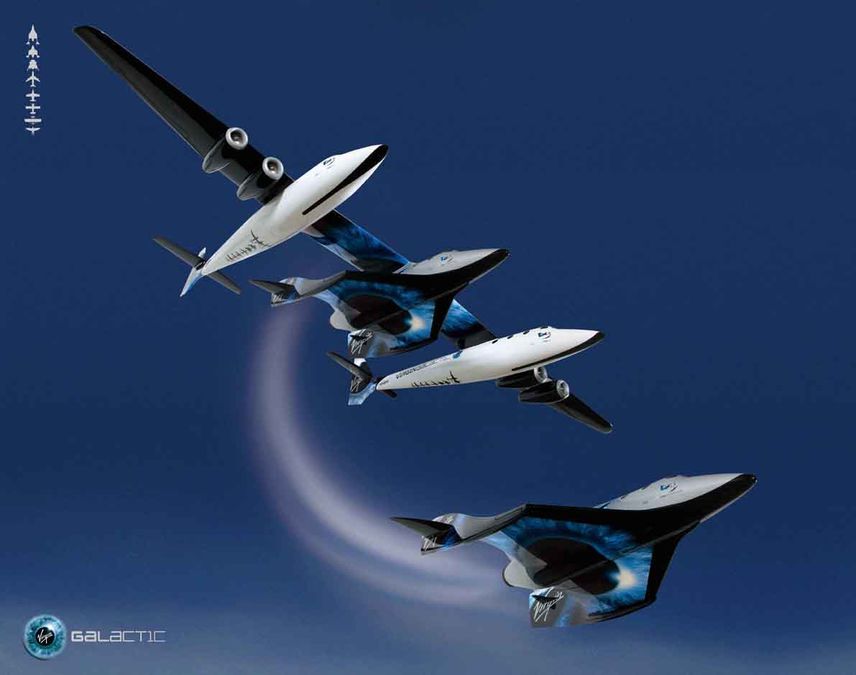Virgin Galactic's suborbital shuttle: Sydney to London in 4 hours

Would you like to step onto a plane in Sydney at 3pm after a late lunch, fasten your seatbelt and be in London four hours later -- which means, given the time zones, arriving at 6am ready for breakfast and a full day of meetings?
It sounds like science fiction, but Virgin Galactic wants to make this a reality. And it could happen sooner than you may think.
There's been plenty of buzz about Virgin's 'space tourism' flights which will skim the edge of space. Over 370 would-be passengers have signed up already, paying a hefty US$20,000 deposit against the final $200,000 ticket price, with first flights expected in 2012.
But space isn't the final frontier for Virgin Galactic. It's a return to the superfast era of the Corcorde, only this time even faster, with a scheduled sub-orbital shuttle to whisk you from Sydney to London in four hours.
Brett Godfrey, former top dog at Virgin Blue, believes that sub-orbital services will be "the next level" beyond supersonic, with substantial appeal to business travellers.
"In another 10 or 15 years it will be $20,000 -- it will be no more than a first-class ticket somewhere" Godfrey says, "and then eventually they will be able to get a slightly bigger rocket with a bit more fuel and they'll be able to get it so it goes trans-con and then around the world. It may not be in my lifetime that it goes commercial but I think it probably will."
Here's how you could be doing the Kangaroo Route circa 2025.
Virgin Galactic's space carrier is an aircraft in two parts, with the 'White Knight Two' transporter cradling the smaller 'SpaceShipTwo' passenger craft beneath its wings.
White Knight Two, which is smaller than a Boeing 737, lifts off from a normal runway and climbs at subsonic speeds to 50,000 feet (just over 15,000 m).
At this point SpaceShipTwo -- half the width of the 737 and only 18 metres (60 feet) long -- detaches and fires its own boosters to soar to 110,000 m. That's about twice as high as Concorde used to cruise.
At this height, with the atmosphere becoming thinner and friction from air decreasing, the passenger shuttle can hit speeds of 4,000 km/h before turning off its engines, coasting along near the rim of space and gliding down to earth.
(The White Knight Two carrier vehicle has long since headed home to pick up its next cargo.)
With London and Sydney being just over 17,000 km apart, SpaceShipTwo travelling at 4,000 km/h and the earth far below spinning at 1,700 km/h, that's almost exactly three hours from Sydney Harbour to the Thames.
Add half an hour for liftoff and half an hour to glide down, and you turn the long-haul Kangaroo Route into a breezy four hour hop –- less time than it currently takes from Sydney to Perth.
The current SpaceShipTwo design carries six people in relative comfort. Concorde flew over forty years ago, and its transatlantic services established that people are happy to sit in seats that are less comfortable than today's premium economy seats to cut their flight time in half.
Of course, today's White Knight Two carrier aircraft is no larger than a Boeing 737. Just imagine the numbers of people that could be carried by a White Knight aircraft the size of an Airbus A380, which can lift over five times as much as White Knight Two. The massive Antonov An-225 cargo aircraft can lift twenty times as much, and the Antonov was designed thirty years ago. This idea clearly has room to scale up.
It's not a huge stretch to consider that future SpaceShipTwo-type aircraft the size of a medium-range jet like the A320 could be whizzing over a hundred passengers up into orbit and dropping them back down across the planet a few hours later. Nor is it beyond the bounds of imagination to think that one enormous carrier could take off from Sydney carrying multiple smaller landing craft destined for multiple destinations across the globe.
This is the nine o'clock departure for New York, London, Tokyo, Rio and Johannesburg. Fasten your seatbelts.


Hi Guest, join in the discussion on Virgin Galactic's suborbital shuttle: Sydney to London in 4 hours